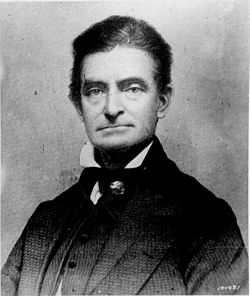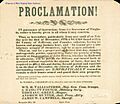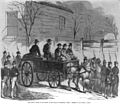Virginia v. John Brown facts for kids
Quick facts for kids Virginia v. John Brown |
|
|---|---|

|
|
| Decided | 31 October 1859 |
| Verdict | Guilty of all charges; sentenced to death by hanging |
| Charge |
|
| Prosecution | Andrew Hunter |
| Defence |
|
The case of Virginia v. John Brown was a very important court trial in October 1859. It happened in Charles Town, Virginia. John Brown was an abolitionist, meaning he was against slavery. He was put on trial because of his actions during a raid on a United States army building in Harpers Ferry, Virginia. (Today, both Charles Town and Harpers Ferry are in West Virginia.)
Brown was found guilty of all charges. He was sentenced to death and was executed by hanging on December 2. He was the first person in the United States to be executed for treason.
It was in many respects a most remarkable trial. Capital cases have been exceedingly few in the history of our country where trial and conviction have followed so quickly upon the commission of the offense. Within a fortnight from the time when Brown had struck what he believed to be a righteous blow against what he felt to be the greatest sin of the age he was a condemned felon, with only thirty days between his life and the hangman's noose.
During most of the trial, Brown was not able to stand. He lay on a pallet (a simple bed).
Contents
What Happened Before the Trial
On October 16, 1859, John Brown led 22 armed men to Harpers Ferry. Five of his men were Black, and 17 were white. Harpers Ferry was an important place where railroads, rivers, and canals met.
Brown's main goal was to take over the federal arsenal (a place where weapons are stored). He planned to use these captured weapons to start a slave uprising across the Southern states. Brown and his men fought with local soldiers and federal troops for two days. During this fight, ten of his men were killed or shot. Five were captured, and five managed to escape. Brown's three sons were part of the raid. Oliver and Watson were killed during the fight. Watson suffered for another day before he died. Owen escaped and later fought in the Union Army.
How the Trial Was Reported
John Brown's trial was the first to be reported all over the country. This was possible because of the recently invented telegraph. Reporters from big newspapers like the New York Herald and The Daily Exchange of Baltimore were there. They had been in Harpers Ferry since October 18.
The news coverage was very intense. Reporters even wrote about the weather. When Brown's wife visited him the night before he was executed, it became a long news story.
One reporter, Edward Howard House, worked for the Herald. He was in Charles Town incognito (in disguise) and used a different name. He even had papers from a newspaper that supported slavery. He asked a visitor not to say his real name out loud. Some of his reports could not be mailed safely. So, he wrapped them around the legs of this visitor, hiding them under his pants.
Artists also reported on the trial. Frank Leslie's Illustrated Newspaper had two artists there. Harper's Weekly used a local artist named Porte Crayon. He was also the nephew of the lawyer prosecuting Brown, Andrew Hunter. One of his drawings is in the gallery below.
Leslie's newspaper told its readers that other papers were publishing fake pictures. He explained how his paper worked. They had engravers and artists ready in a New York hotel. Once a sketch arrived from Charles Town, 16 artists worked at the same time. They split the sketch into 16 parts to quickly turn it into an illustration for printing. These illustrations were so popular that the Yale Literary Magazine made fun of them. They published drawings of "Governor Wise's shoes" and "John Brown's watch."
Why the Trial Was Important
This trial was very important for the history of the United States. It was closely connected to the Civil War that started soon after. Historian Karen Whitman said that John Brown's strong behavior during his time in jail and during the trial made it seem like slavery itself was on trial, not just Brown.
According to Brian McGinty, the "Brown of history" was created during his trial. If Brown had died before his trial, he might have been seen as just a "madman." He might have been forgotten in history. Robert McGlone added that the trial made Brown's image bigger and more important. Brown worked to shape his public image even before the raid. This continued after his powerful speech when he was sentenced.
After his arrest, Brown wrote many letters. After he was found guilty and sentenced, the judge let him have visitors. In his last month alive, he gave interviews to reporters and anyone else who wanted to talk to him. This was made easier by the jailer, Captain John Avis. Captain Avis was "just and humane" and treated Brown with "sincere respect." He did everything he could for his prisoners. His kind treatment of Brown was criticized by many Virginians. Brown's last meal and the last time he saw his wife were with the jailer's family at the jail.
How the Trial Led to the Civil War
The trial and the way people reacted to it had a huge impact. One person wrote that John Brown's actions themselves did not have a big effect. But the way the North reacted to them caused a lot of damage. The speeches, sympathy, and approval in the North made people in the South feel very strongly. They felt that the North was supporting Brown's actions.
Before this, many people did not fear that the United States would break apart. But after the trial, fears grew that the country would split. The desire for the Southern states to leave the Union became "sincere" and "unanimous." It was no longer just a few extreme people who wanted to separate.
The executions of Brown and his followers were very memorable in Virginia. Some people thought it would have been wise for the Virginia governor to treat Brown as mentally unwell. But the strong show of punishment from Virginia made anti-slavery feelings in the North much deeper and wider. Brown gave his life for his cause in a heroic way. This impressed people in the North more than they even realized.
Reenacting the Trial
During the Civil War Centennial (100-year anniversary), a local author named Julia Davis Healy wrote a play called The Anvil. She wrote it about the trial for the Jefferson County Civil War Centennial Committee. The play was first performed in 1961. It was performed in the same courtroom where the trial happened, in the Jefferson County Courthouse. The courtroom was "jampacked" (very full).
The play had 45 actors, most of whom lived in Charles Town. Real old items were used in the play. For example, the actor playing Brown was shackled with the same handcuffs Brown had worn. Most of the words spoken in the play were almost exactly what was said at the real trial. The play's title, The Anvil, comes from a line in the text: "At times in history a man appears, pointed like a compass at one star—a man of iron, an anvil on which God beats out his purposes."
Students from Shenandoah University reenacted the trial again in 2019. A version of the reenactment will be available at the Shenandoah Valley Civil War Museum in Winchester, Virginia.
Images for kids
-
A warning to citizens of Jefferson County, Virginia, and nearby areas to stay home and not attend John Brown's execution.
-
Broadside from mayor of Charles Town, Virginia, warning citizens to remain in their houses.










